#arabic treatises
Explore tagged Tumblr posts
Text
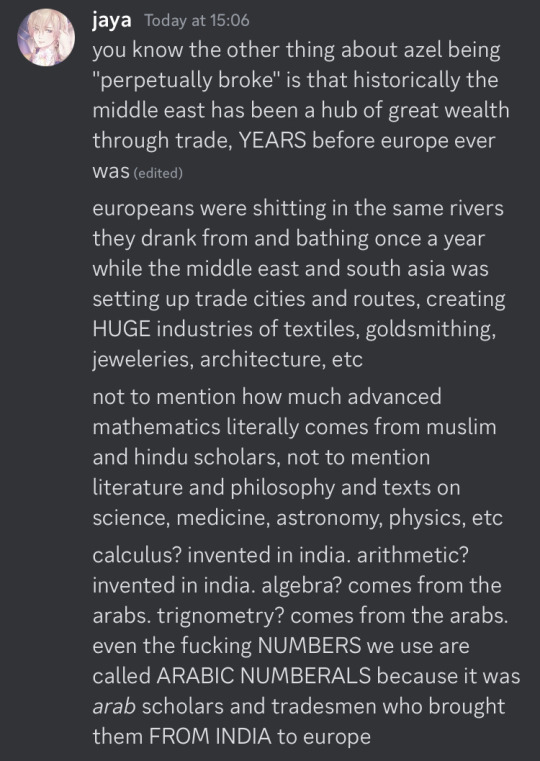

I had a lot of things to say about Azel Radwan :) and his description being “perpetually broke” :)) and his beast encyclopedia highlighting that he gets his gold from Silvio :))) very coincidental that he has an Arabic name and comes from an explicitly middle east-coded country, of course
#rant.txt#if i had to list all the craft industries and academics and luxury goods that were invented by historical indians and arabs#we would be here all fucking day and im not even joking. SO MUCH of the wealth and academic treatises that elevated europe are from us#saw someone on tumblr make a post like ‘haha what if azel was secretly emidio actually’ and i deadass fucking saw RED#like seething with anger. how fucking dare you stand there and say a WHITE EUROPEAN character is actually a brown man???#the ONLY brown man in game mind you even if he doesnt look like it. my post on jin and luke was just speculation and headcanons#but azel is EXPLICITLY coded arab. fuck you fuck yiu FUCK YOU for saying hes emidio#and putting emidio’s crimes on him when emidio fucking ricci is a white european piece of shit#I should go drink some mango juice before i burst a blood vessel gods
9 notes
·
View notes
Text
LJS 456 is a popular treatise that claims to be a letter from Aristotle to Alexander the Great on a variety of topics, written in Andalusia, A.H. 797 (1394). Originally written in Greek or Arabic (origins are unclear), also translated into Latin
Online:
#medieval#manuscript#arabic#14th century#philosophy#treatise#book history#rare books#spain#andalusia
39 notes
·
View notes
Text
Writing Reference: Alchemy
Some scholars say alchemy comes from the Greek cheo, meaning “I pour” or “I cast,” since much of alchemy has to do with the working of metals.
But many believe the word comes from the Egyptian Khem, meaning “the black land” (land with black earth), and see that as indicating Egypt as alchemy’s place of origin:
The Arabic article al was added to Khem to give alchemy.
Alchemy is an ancient art, at the heart of which lies the manufacture of a mysterious substance called the Philosopher’s Stone.
Later, as the science (some call it a pseudoscience) progressed, the article was again dropped, to become chemistry.
Alchemy certainly is the early history of chemistry.

The Philosopher's Stone - the highly desirable and legendary object that is said to transform base metals—such as lead—into gold.
However, the gold in this instance symbolizes not just the valuable metal, but enlightenment and eternal life, and Alchemists are concerned with their own spiritual and personal development as well as the pursuit of the seemingly unattainable goal.

The Chinese differentiate these different kinds of alchemy as nei-tan (the alchemy of spiritual transformation) and waitan (the straightforward “lead-into-gold” type).
The motto of the Alchemists is Solve et Coagula, meaning “Solution and Coagulation.”
The work of the early Alchemists was necessarily a secretive and clandestine matter, and its secrets are still held within a rich encrustation of symbols, pictures, oblique references, double meanings, and riddles.
Alchemical symbolism features animals, birds, colors, and parables as well as archetypal symbols such as the Cosmic Egg.
The key tenets of alchemy are encompassed in something called the Smaragdina Tablet, or the Emerald Tablet.

The tablet is said to have been found by Alexander the Great in the tomb of Hermes Trismegistus (Hermes the Thrice Great) who is the founder of all things alchemical.
The Alchemical Tradition exists/existed in Ancient Egypt, China, and India, but its most recent incarnation was in medieval Europe.
Those who dabbled in alchemy include the famous and the infamous, such as John Dee (astrologer to Queen Elizabeth I), Paracelsus, Albertus Magnus, Christian Rosenkreuz, Nicholas Flamel, and Isaac Newton.
Some of the chemical treatises are befuddling to even the most learned of scholars, but the very word “alchemy” is almost in itself a symbol, conjuring up images that are magical, mystical, and marvelous.

Sources: 1 2 3 4 ⚜ Writing Notes & References
#writing reference#alchemy#symbols#writeblr#langblr#linguistics#literature#fantasy#writers on tumblr#writing prompt#poetry#poets on tumblr#spilled ink#dark academia#light academia#lit#writing inspiration#writing inspo#writing ideas#creative writing#writing resources
244 notes
·
View notes
Photo

Not a cell phone in sight.
Image from an illustrated 17th-century Persian translation of a 13th-century Arabic treatise by Zakariya al-Qazwini translating as Marvels of Things Created and Miraculous Aspects of Things Existing. More here: https://publicdomainreview.org/collection/marvels-of-things-created-and-miraculous-aspects-of-things-existing
97 notes
·
View notes
Photo

Menelaus of Alexandria
Menelaus of Alexandria was a Greek astronomer, scientist, and mathematician who lived around 100 CE. Menelaus made a significant and lasting contribution to the fields of astronomy, geometry, and trigonometry. His major work, the Spherics survives and presents what is today called Menelaus' Theorem. The theorem uses lettered diagrams of pure geometry to calculate spherical triangles or distances across a sphere with implications for the practical study of astronomy such as the trajectory of planets. Menelaus, and others like him, reduced the physical world to a purely geometric one, and so he was then able to calculate the unmeasurable, an approach which became the very foundation of modern science.
Life & Works
History is almost totally silent regarding any biographical details of Menelaus. All that we do know is that he made a series of astronomical observations in Rome in 98 CE and that he was known to the Greek writer Plutarch (c. 45-50 CE - c. 120-125 CE). We also know the titles of several of his works, mostly via references in the works of others, notably later Arab writers and compilers of (now mostly lost) ancient texts. These works include:
Spherics (Sphaerica) - Menelaus' most important work, which survives as an Arabic translation. It deals with the mathematical studies of spheres and the implications thereof on the subject of astronomy. The work is divided into three books, the first of which examines spherical triangles, defining them and proposing theorems based on the 4th-3rd century BCE Greek mathematician Euclid's work on plain triangles. This is the earliest surviving detailed study of spherical triangles. The second book concerns spherical topics with observations on astronomy similar to those made by Euclid and the astronomer and mathematician Theodosius of Bithynia (l. c. 100 BCE). The third book is a much more innovative treatise on the fundamental principles of spherical trigonometry, again, the earliest known such study. It presents Menelaus' Theorem (see below) and the Rule of Four Quantities and the Law of Tangents.
Specific Gravities - another surviving work in Arabic translation. This book was dedicated to the Roman emperor Domitian (r. 81-96 CE).
Elements of Geometry - three books mentioned by the Persian scholar al-Biruni (b. 973 CE) and likely a collection of problems concerning Euclidean geometry.
A treatise on chords in a circle, possibly some form of early trigonometric table. This work is referred to by the 4th-century CE mathematician and commentator Theon of Alexandria.
A work on the signs of the zodiac, which is referred to by the 4th-century CE mathematician Pappus of Alexandria.
Three works mentioned in the 10th-century CE Fihrist, an Arabic catalogue by Ibn al-Nadim. These are Book on the Triangle, On the Knowledge of the Weights and the Distribution of Different Bodies, and an untitled work on mechanics. These texts possibly included Menelaus' estimation of the precession of the equinoxes.
Menelaus helped in the progress of science by his reduction of the physical (planets) to the purely geometrical (mathematical diagrams).
Continue reading...
29 notes
·
View notes
Text
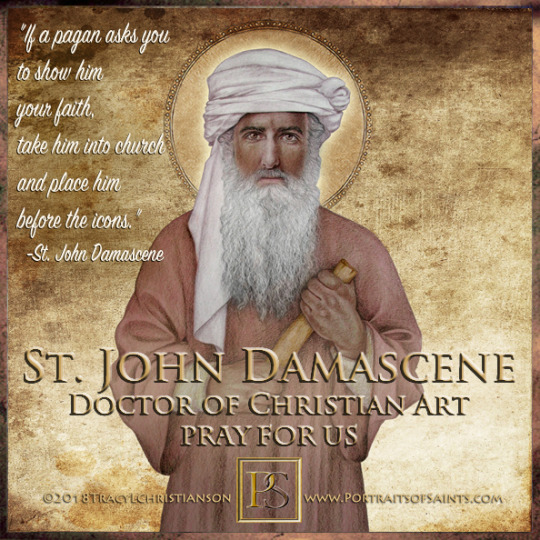
Happy Feast Day
Saint John Damascene or Saint John of Damascus
Doctor of the Church
c. 676-749
Feast Day: December 4 (New), March 27 (Trad)
Patronage: Pharmacists, icon painters, theology students
Saint John of Damascus or Saint John Damascene, a Syrian monk and priest, was the last of the Greek Fathers. He became a trusted magistrate under Arab rule and a monk at Mar Saba monastery near Jerusalem where he died. His defense of the veneration of icons procured him the title of “The Doctor of Christian Art.” He is known for his poems, hymns or “canons,” and his treatise “Exposition of the Orthodox Faith.” He was declared a Doctor of the Church in 1890.
Prints, plaques & holy cards available for purchase here.
36 notes
·
View notes
Text
Genshin Character Names` Meanings Pt. 4
Tighnari | Most likely a reference to Arab Muslim botanist (as well as traveler, poet and physician) Al-Tighnari (born in village Tignar), who wrote a treatise on Middle East agriculture
Collei | Uncertain, but there seemingly is a Persian name Collei that means «Aware», «Sentimental», or «Noble»; Also literally «Lost» in Welsh
Cyno | Originates from Cynopolis, an Egyptian city which used to be centre of Anubis cult, and as we all know, Cyno is based on Anubis
Sethos | Most likely references Seth, the God of deserts, storms, disorder, violence and foreigners in Ancient Egypt. Known to have accompanied Ra on his barque in repelling Apep, but in the Osiris myth depicted as the usurper who murdered and mutilated his own brother, who is Osiris himself
Dori | Literally «Shining», «Glowing» in Persian, also derived from the word dor (دُر) which means «Large Pearl»
Nilou | «Water Lily», «Lotus» – Persian Name
Candace | «Clarity», «Whiteness» – An ancient title derived from word Kandake, once used by queens of Ethiopia; has Latin roots
Dehya | «Leader of Soldiers» – Algerian Amazeigh/Berber name, which refers to Kahina Dehya, the female Algerian priestess, who was a religious and military leader
Layla | Literally «Night» in Arabic
Faruzan | «Luminous», «Shining», or «Resplendent» – Persian Name
Alhaitham | Haitham is a first name and it means «Young Eagle» or «Young Hawk». Meanwhile Al is a prefix usually used in Middle East last names before the name of the family/tribe itself. Basically, it is a definite article, like 'the' in English. He is also most likely named so after Hasan Ibn al-Haitham (Latinicized version of his name also sounds like Alhazen) who was an Arab mathematician, astronomer and physicist during the Islamic Golden Age
Kaveh | «Of Royal Origin» – Persian/Iranian Name; Might be based on Kaveh the Blacksmith from Iranian mythology, who launched a national uprising against the evil foreign tyrant Zahāk and re-established the rule of Iranians
Nahida | «Delightful», «Gentle», «Kind», «Soft» – Persian Name. Another version – Nahiya, means «Advisor»
Kusanali | Derived from the Pali words «kusa» (kusa-grass, a sacred plant used in Hindu ceremonies) and «nāḷi» («a hollow stalk or tube»).
Buer | Comes from Governor Buer, the 10th of Goetia Demons
Rukkhadevata | रुक्खदेवता – "tree-goddess" in Shaivism is a Yakṣiṇī who is worshiped as the goddess of wealth or the guardian spirit of practitioners. The Yakṣiṇīs are the female counterparts of the Yakshas in Hinduism and Buddhism, and also appear in Jātaka literature, where they are considered as local deities living in trees and sometimes referred to individually as "rukkha-devatā".
Cuilein-Anbar | Literally «Darling Amber». Cuilein (directly translating to «pup/cub») is a Gaelic term of endearment commonly used for young animals, equivalent to «darling», while anbar is an Arabic word meaning «amber».
Mehrak | «Like the Sun» – Persian Name
Faranak | Derived from the word پروانه (parvâneh), which means «butterfly» in Persian
Dunyarzad | Likely named so after Dunyazad (دنیازاد in Persian), who is the younger sister of Queen Scheherazade from One Thousand and One Nights
Sorush | Originates from Zoroastrian divinity of «Conscience» and «Observance», with its name having those two exact meanings
Apep | Based on an ancient Egyptian deity of darkness and disorder, also known as Aphoph or Apophis, who also was often depicted as a snake
~~~~~~~~~~~~~~~~~~
........Hi
Not even gonna make up excuses this time, just want you to know that I do have an intention to finish these series, it`s just that God knows when I actually will
In any case, I wanted to add Jeht as well, but I couldn't find a reliable source that would tell me where her names comes from, so I would be grateful if anyone knowledgeable helped me out here. I think I saw a version that says it's an Arabic name meaning «Freedom Lover» or «Scholar», but I'm not sure if that's right??
Anyways, see ya soon, hope you'll have a great year, take care of yourself, stay hydrated and bye.
#genshin impact#genshin impact sumeru#tighnari#collei#genshin impact cyno#cyno#genshin impact dori#nilou#candace#genshin impact layla#faruzan#alhaitham#kaveh#dehya#genshin impact sethos#genshin impact nahida#nahida#greater lord rukkhadevata#genshin impact sorush
20 notes
·
View notes
Text

Magic = science
Alchemy = magic = science = It was, in its deepest sense, the transmutation and transformation of substances.
The mystical ideas of alchemy compared the material transmutation to that of the human spirit and the knowledge of god.
Because you were attempting (chemistry) finding out elements and mixing them together to create something else.
Magick - alchemy - chemistry - other sciences
Alchemy and magick are related in a number of ways, including:
1. Medieval scrolls - Some medieval scrolls combine alchemy, medicine, and magic, including spells, recipes, and alchemical processes
2. The philosopher's stone - This mythic substance was believed to be able to turn base metals into gold or silver, and to create an elixir of life.
3. The relationship between the physical and the unseen - Alchemy and astrology are both concerned with relating the physical world to the greater universe. In alchemy, transmutations of elements were believed to correspond to transmutations of the spirit
4. Alchemy was considered a science in the medieval period, and was a precursor to chemistry. Pope John XXII banned alchemy in 1317, making it illegal in Christian and Western countries.
The Emerald Tablet 
Tis true without lying
certain and most true.
That which is below
is like that which is above
and that which is above
Is like that which is below
to do the miracle of one only thing.
And as all things have been
and arose from one
by the mediation of one:
so all things have their birth
from this one thing by adaptation.
The Sun is its father,
the moon its mother,
the wind hath carried it in its belly,
the earth is its nurse.
The father of all perfection
in the whole world is here.
Its force or power is entire
If it be converted into earth.
Separate thou the earth from the fire
the subtle from the gross
sweetly with great industry.
It ascends from the earth to the heaven
and again it descends to the earth
and receives the force of things superior and inferior.
By this means you shall have
the glory of the whole world
and thereby all obscurity shall fly from you.
Its force is above all force,
for it vanquishes every subtle thing
and penetrates every solid thing.
So was the world created.
From this are and do come
admirable adaptations
where of the means is here in this.
Hence I am called Hermes Trismegist, having the three parts
of the philosophy of the whole world.
That which I have said
of the operation of the Sun
is accomplished and ended.
Hermes Trismegistus is a legendary alchemist and ancient Egyptian sage who is associated with the Philosopher's Stone:
Philosophers stone - An elusive substance that alchemists sought to create as the ultimate goal of their work. The stone symbolized immortality and spiritual enlightenment
The emerald tablet - work of alchemy and is often attributed to Hermes Trismegistus. However, German scholar Julius Ruska traced the text back to the 7th–9th century Arab treatise Kitab Balaniyus al-Hakim fi'l-`Ilal
The Seal of Hermes - An alchemical procedure for creating the Philosopher's Stone that involved sealing a glass vessel containing a mixture of materials. The vessel was then heated for 30–40 days. The term "hermetically sealed" comes from this procedure.
Distillation - A process used by alchemists to change matter from one form to another. The method was attributed to Hermes Trismegistus, which is why it's described as "hermetically sealed"
“As above, so below
As within, so without
As the universe, so the soul. “
#magic#magick#pagan witch#spell#spell jars#spellcraft#spells#spellwork#witchy#witchy shit#alchemia#alchemist#alchemy#as above so below#hermeticism#hermetica#emerald tablet#transmutation#philosophy#philosopher’s stone
14 notes
·
View notes
Text
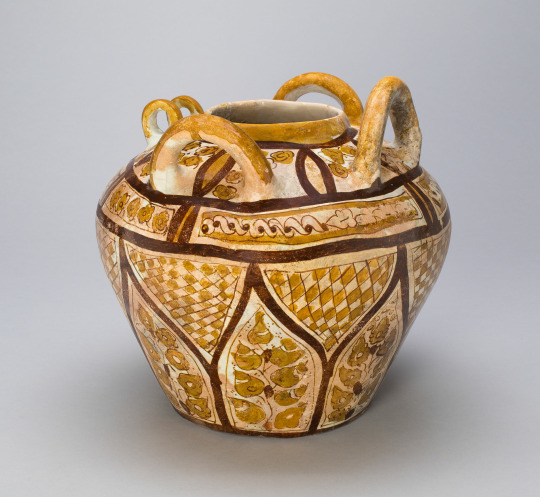
Jar
Iraq, Abbasid Caliphate (750–1258), 9th century
During the Abbasid caliphate (750-1258), relative peace and an initially consolidated government allowed for the arts and sciences to flourish. The caliphate’s first capital, Baghdad, and its later capital, Samarra, became centers for cultural and commercial production. Some of antiquity’s most important scientific treatises, such as Ptolemy’s writings on the stars, were translated into Arabic while court inventors made advancements in medicine, chemistry, and mathematics. In the arts, poets such as Abu Nuwas invigorated classical Arabic literature, and artists developed a style of decoration that the west would later call “arabesque,” which refers to repetitive vegetal patterns that can be found in almost every medium of Islamic art.
18 notes
·
View notes
Text
Grimmer
A grimmer (Merch /ˈgɾɪ.mə/, Borlish grimmour /gʀɪˈmuʀ/) [computer], formerly and formally an augrimmer, is a device that can be given methods to carry out sequences of arithmetic or logical operations. These methods enable grimmers to perform a wide range of tasks. Grimmers are the substrate of the pistol mesh [Internet], which links together billions of such devices.
Calculating devices from the earliest abaci prefigure the grimmer, but its true potential (the ability to perform essentially arbitrary computation, given the correct instructions) arose from theoretic discussions on the possibility of self-replication. In the eighteenth-century, Rachel Desselut argued that in order for living matter to duplicate, its "Form" must contain a readable "Method" describing its construction. In this way she predicted the form-method [hardware-software] separation which is a key feature of modern grimmer operation.
Etymology
The word grimmer is a clipping of augrimmer, literally "one who calculates, one who performs mathematical computation"; the word referred to a profession until the mid-twentieth century. This derives from noun augrim "computation, calculation", which originally meant "calculation using Arabic numerals" in particular, and which was a loan via French augrisme from Medieval Latin algorismus. This reflects the name of Persian mathematician al-Khwarismi, whose works introduced the positional number system to Europe.
References
Parable of the Mute Bookbinder, 1743 philosophical treatise by noblewoman Rachel Desselut
The Grimmer Hall: Developments in Early Methodics, 1999 scholastic quire written by New Leudong historian and methodist Cai Sonquo during his tenure at the University of Mehannin [~Brisbane]
8 notes
·
View notes
Text
Third part of the bookscans of Al Andalus. Historical Figures, here's the previous part
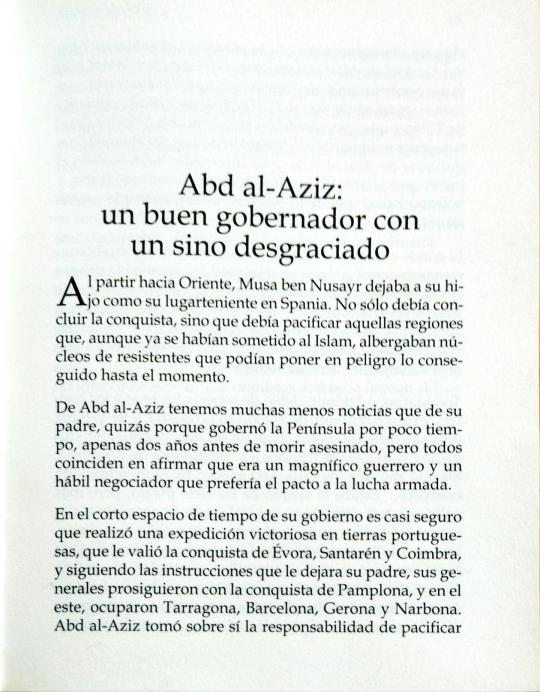
Abd al-Aziz: a good governor with an unfortunate fate
When leaving for the East, Musa ben Nusayr left his son as his liutenant in Spania. Not only he had to conclude the conquest, but had to pacify those regions that, although they had already submitted to Islam, housed groups of resisters who could put in danger what has been achieved so far.
We have much less news about Abd al-Aziz than about his father, perhaps because he ruled the Peninsula for a short time, just two years before being murdered, but they all agree that he was a magnificent warrior and a skilled negotiator who preferred pact to armed struggle.
In the short period of time of his government it is almost certain that he carried out a victorious expedition in Portuguese lands, which earned him the conquest of Évora, Santarém and Coimbra, and following the instructions that his father left him, his generals continued with the conquest of Pamplona, and in the east, they occupied Tarragona, Barcelona, Girona and Narbonne. Abd al-Aziz took upon himself the responsibility of pacifying

some rebellious areas of eastern Andalusia and the Levant. He owes himself the conquest of Málaga and Elvira and the advance on lands of Murcia, at that time in the hands of a Visigoth nobleman, Teodomiro, vassal of the kingdom of Toledo, who ruled the region as a practically independent prince. And here we can see the negotiating spirit of Abd al-Aziz, who knew take good advantage of the pact he established with Teodomiro, Tudmir in Arabic, and the name by which it will henceforth be known the Murcian region.
The Christian count and the Muslim governor engaged conversations in which the second offered the first the maintenance of all his prerogatives, as count and as Christian, as well as total respect for his subjects, in exchange for the recognition of vassalage, the payment of an annual tribute and the delivery of seven strongholds, a delivery that would be carried out immediately.
Teodomiro, or Tudmir, must have weighed the pros and cons. The Christian kingdom of Toledo no longer existed, and it made no difference to be a vassal of the Goths as well as the Muslims. Without a doubt, too paid tributes to Rodrigo's monarchy and those that now Abd al-Aziz imposed were not too onerous... There was the matter of the seven strogholds, but it was better to give in on something that lose everything. The document signed between Teodomiro and the Muslim leader, one of the few treatises of this type that have come down to us, and it specifies that everyone, the count and his vassals, will preserve their religion and their churches, will maintain their rights of sovereignty and will not be bothered at any time, neither in their lives, nor in their estates,

as long as they comply with what is stipulated. And what was stipulated was the delivery of Orihuela, Baltana, Alacant, Mula, Villena, Lorca and Ello. The annual tribute consisted of one dinar in cash, four bushels of wheat and four of barley, four measures of new wine, four of vinegar, two of honey and two of oil. This tax was reduced by half for the slaves.
If we have detailed the characteristics of this treaty, it is because of its rarity. and because, according to Levy Provençal, it is the first document diplomat of Muslim Spain.
Abd al-Aziz married the widow of King Don Rodrigo, at least that is what several historians say. It seems that they met after the fall of Mérida, when the royal widow left the city with another group of captives. Some consider this wedding as a real love story, at least on the part of Abd al-Aziz, since it seems that he did not take another wife. The Arab chroniclers call her Ailo and the Christians Egilona. Some say that her husband allowed her to keep her religion, gesture that was very well received among the Mozarabs, and others say that converted to Islam and was renamed Umm'Asim, “the mother of Asim", as soon as the only son she had with Abd al-Aziz was born.
The couple lived almost always in Seville, where it is still preserved, in the gardens of the Alcázar, a white tower of typical African construction, known as "the Tower of Abd al-Aziz". However, if they were happy, their happiness must have lasted little, because at the same time Seville, an envoy of the Caliph Sulayman, Ziyad ben Udhara, assassinated him in the church of Santa Rufina, converted into a mosque, while Abd al-

Aziz performed the pious duties of prayer. The charge against him, according to the caliph, was abuse of power. He was beheaded and his head was sent to Damascus.
A confusing time passed in Muslim Spain that was left without a governor. The Spanish Arabs decided that the son of a sister of Musa ben Nusayr would occupy the position until the one appointed by the caliph arrived.

The oddyssey of Prince Abd al-Rahman the Immigrant
After the violent death of Abd al-Aziz, the governors of the Muslims succeeded one another in Spain at an astonishing speed. Some barely held office for six months and It seems that only one of them lasted for about five years. They were difficult times in Muslim Spain. Had have deepen the conquest, quell the possible rebellions that could arise among groups of defeated and, also, and not less important was to make peace between the different Muslim factions, without dismissing the possibility of carrying out raids over lands of Gaul.
In the East, in turn, there was a complicated situation, such as result of the dissent of various religious groups that put the unity of Islam is endangered. Jarichis and Shiites conspired, already openly, against the Umayyad dynasty that reigned in those moments, without the caliphs having the strength or intelligence enough to face that situation that, each time, became more dangerous for them.

The flag of rebellion against the Umayyads was raised everywhere in the Muslim empire, awaiting the arrival of the "imam hidden" that was going to restore to Islam all the purity of its faith and all the splendor of its early days. The black flags, symbol of a new dynasty, the Abasid, were already flying in the Furasan and in the large Iraqi city of Cuta. Abu-l-Abbas Abd Allah proclaimed himself caliph, as a descendant of a first cousin of Muhammad and his son-in-law Ali. According to him, he was the imam that everyone expected and fought Marwan II, the last Umayyad caliph who would die with weapons in hand on July 7, 750.
The new Abbasid caliph, even before the death of Marwan, had already began the extermination of all the Umayyad princes who were left. They were persecuted to death, without mercy, and their bodies, as the maximum punishment, were left unburied. And for what no one would escape from that carnage that would cost its executioner the nickname "the bloodshed", resorted to a cruel stratagem. He proclaimed a false amnesty in which they trusted the relatives of the last caliph, which allowed, in one fell swoop, end the lives of about eighty people belonging to the Umayyad royal family, at Abu Futrus, near Jaffa, Palestine.
Only two Umayyads, grandsons of Caliph Abd al-Malik ben Marwan, distrusting the amnesty proclaimed by their enemy, managed escape from that horrible massacre. It was about the brothers Yahya ben Muawiya and Abd al-Rahman.
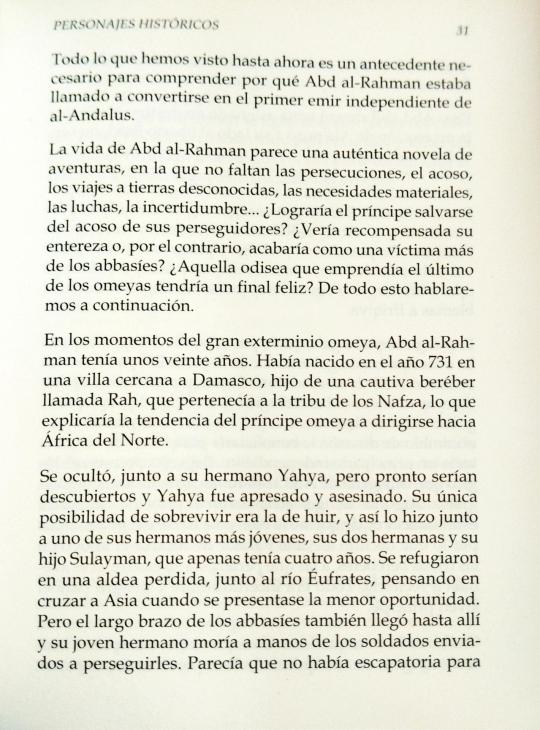
Everything we have seen so far is a necessary background to understand why Abd al-Rahman was called to become the first independent emir of al-Andalus.
The life of Abd al-Rahman seems like a real adventure novel, in which there is no shortage of persecutions, harassment, trips to unknown lands, the material needs, the struggles, the uncertainty...The prince would manage to save himself from the harassment of his pursuers? He would see his integrity rewarded or, on the contrary, would he end up as another victim of the Abbasids? That odyssey that would the last of the Umayyads undertake have a happy ending? From all of this We will talk next.
At the time of the great Umayyad extermination, Abd al-Rah-man had about twenty years. He was born in the year 731 in a town near Damascus, son of a Berber captive named Rah, who belonged to the Nafza tribe, which would explain the tendency of the Umayyad prince to head towards North Africa.
He hid, along with his brother Yahya, but they would soon be discovered and Yahya was captured and killed. His only chance to survive was to flee, and so he did with one of his younger brothers, his two sisters and his son Sulayman, who was barely four years old. They took refuge in a lost village, next to the Euphrates River, thinking about cross to Asia when the slightest opportunity presented itself. But the long arm of the Abbasids also reached there and his young brother died at the hands of the soldiers sent to pursue them. It seemed that there was no escape for

the Umayyad prince, when he saved himself by swimming across the Euphrates River.
But Abd al-Rahman was assigned a glorious destiny and protection of Allah he placed at his side the freedman Bard, a servant and counselor, who will accompany him throughout his life, even in the most difficult and who will maintain unlimited loyalty towards his lord, so unfortunate at that time. Bard managed to collect some wealth belonging to Abd al-Rahman and join him in Palestine. They undertook a long and dangerous journey across the Isthmus of Suez, trying to go unnoticed and rushing long and exhausting days, they arrived without problems at Ifriqiya.
This region was ruled by a Fhirid Arab who aspired to be appointed governor of Spain. He was a close relative of the Walí of al-Andalus. Some supporters of the Umayyads were refugees in Ifriqiya and, although the governor said he was opposed to the Abbasids, he thought that the change of dynasty would benefit him to make his territory an independent principality. Under this premise it is logical that Abd al-Rahman's arrival did not please him at all. Some friends warned the Umayyad prince of this situation and it was better not to trust the governor, so he decided to move away and try to enlist the support of the Berber tribes, to which his mother belonged, if they agreed to receive him. Everything was uncertainty and danger for the young prince.
Four years passed on these trips, always in search of support, of tranquility, of survival, while
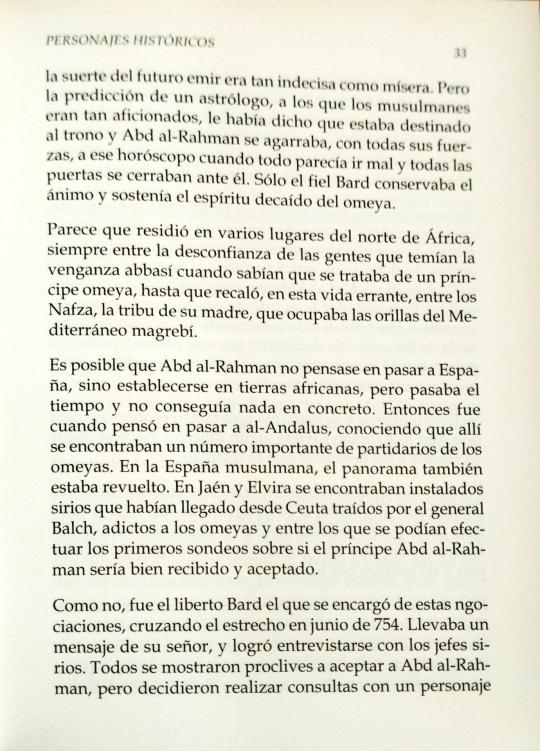
The fate of the future emnir was as indecisive as it was miserable. But the prediction of an astrologer, to whom the Muslims were so fans, had told him that he was destined for the throne and Abd al-Rahman clung, with all his strength, to that horoscope when everything seemed to be going wrong and all the doors were closing before him. Only the faithful Bard kept his spirits and sustained the fallen spirit of the Umayyad.
It seems that he lived in various places in North Africa, always between the distrust of the people who feared Abbasid revenge when they knew that he was an Umayyad prince, until he landed, in this wandering life, among the Nafza, his mother's tribe, who occupied the shores of the Mediterranean Maghreb.
It is possible that Abd al-Rahman did not think of going to Spain, but settle in African lands, but time passed and no achieved nothing in particular. That's when he thought about moving on to al-Andalus, knowing that there were a important number of supporters of the Umayyads. In Muslim Spain, the panorama was also mixed. In Jaén and Elvira they were installed Syrians who had arrived from Ceuta brought by the general Balch, addicted to the Umayyads and among whom the first polls on whether Prince Abd al-Rahman would be good received and accepted.
Of course, it was the freedman Bard who was in charge of these negotiations, crossing the strait in June 754. He carried a message from his lord, and managed to meet with the Syrian leaders. Everyone was willing to accept Abd al-Rahman, but decided to consult with a very important person

which was the most considered in al-Andalus. It was about the Qaysi chief, al-Sumayl, at that time governor of Zaragoza, who was defending the stroghold from the Berber siege and Kalbi Arabs. Once this coalition was defeated, al-Sumayl listened to the proposals of Bard and his companions and took his time to think about it.
Many months passed before receiving a reply, which was positive, but in the end, fearing the Abbasid reaction or fearing that an Umayyad restoration would take away freedom from the Arabs of al-Andalus, he withdrew his support for the project. What to do? Request Abd al-Rahman to desist from setting foot in Spain or request help from other groups such as the Yemenis who had been cruelly crushed in the battle of Secunda? They decided for this last option and, from this moment, with his help, the panorama was cleared for the Umayyad prince.
A boat was chartered and a financial contribution was made so that Abd al-Rahman had some money and could pay his ransom to the Berbers who held him.
Finally, after countless waits, after long trips, after untold deprivations, August 14, 755, Abd al-Rahman set foot on Hispanic soil in the port of Almuñécar. Now a new stage began, not exempt from problems and battles to fight.
The governor of al-Andalus was, at that time, Yusuf al-Fihrí, busy suppressing a rebellion by the Basques. He decided go to Córdoba leaving his son in charge of Zaragoza and the defense of Pamplona. However, he soon learned of defeat of his hosts and the arrival of the Uma-
#al andalus#al andalus history#al andalus. personajes históricos#al andalus. historical figures#book scans#bookblr#historyblr#abd al-aziz ibn musa#abd al rahman i#abd al rahman i of córdoba#abd al rahman i de córdoba#egilona#queen egilona#ailo#abd al-aziz#sorry for the cliffhanger
8 notes
·
View notes
Text
Chakras and Psychic Centers in the Western Magical Traditions.

This post was inspired by @ditchdwellersupreme in a discord server that made me think deeply and sent me down a rabbit hole about how valid is the approach in this sense. https://hareesh.org/blog/2016/2/5/the-real-story-on-the-chakras Christopher Wallis, a Sanskrit scholar and practitioner goes in depth about them but the points he talks about in that specific blog is that:
There's not just one chakra system in the original tradition, there are many.
The chakra systems are prescriptive, not descriptive.
The psychological states associated with the chakras are completely modern and Western.
The seven-chakra system popular today derives not from an ancient scripture, but from a treatise written in 1577.
The main purpose of a chakra system is to function as a template for nyāsa — installation of mantras and deities.
The seed-mantras that you think go with the chakras actually go with the elements that happen to be installed in those chakras.
I am not here to argue on the validity of the practice of 7 chakras but on the practicalities of the practice itself, how it affect western practices and methodology and if they do have a place in western magical traditions?
hmm...if you imagine that the chakras are prescriptive and that they install mantras and deities into our bodies...then what about Phylacteries and talismans. What about physical body and letters in regard to that? Chaim Vital wrote: 'Know that in each and every organ of a person's body, there are letters engraved, informing us about that individual's actions. But the primary place is the forehead, as indicated earlier.' Some people might think of Jewish practices as not Western in nature and that's valid, but the Testament of Solomon also shed light on this when it associate a body part to a demon/angel combo. a fragment of Celsus from Origen says:
… the Egyptians say that the body of man has been put under the charge of thirty six daimons, or ethereal gods of some sort, who divide it between them, that being the number of parts into which it is divided (although some say far more). Each daimon is in charge of a different part. you can find a decan master list here , the sacred book of ascelpius talks about it from an astrological point of view: Aries is the head of the world, Taurus the neck, Gemini shoulders, Cancer breast, Lion the back, shoulder blades, heart and ribs, the Virgin the belly, Libra buttocks, Scorpio the pubis, Sagittarius the thighs, Capricorn the knees, Aquarius the legs and Pisces the feet. All of these could be seen as a way of diagnosing and medical magic, but also they have their own significance in this practice. I don't say to mish-mash the systems together but maybe there's more to it than what we think is not. Arab magicians write talisman for dream and tie it to their right upper arm, why the right upper arm and not the left? phylactery like the one used in the headless one is tied on the forehead...is there something more to it? I am not saying take all the chakras willy nilly, just that there's something to it. Heart, Stomach/lower belly, and top of the head.
Clearly I am taking the side of "yeah bro use dem chakranaynays" and honestly, my own practice didn't take off until I used a specific practice that dealt with dream incubation through visualizing the planetary symbols on the medulla oblongata following the Chaldean order with each symbol lasting a week. Does that mean I encourage reckless experimenting with them? of course not, they hurt and you would hurt yourself if you push yourself too hard with them. You use them as a part of a whole system, maybe you just use pillar and spheres to energize yourself or visualize the nadi/channel during nine bottle pranayama. The usual recommendation is to follow eastern procedure and it might feel weird for some people, it's honestly better to take a step back and see your own practice. The spirits would work with/without it, but your body is still gonna respond to spirits on some physiological level. Pragmatically speaking some spirits might even be more willing and might perform Nyasa for you. If you think about it, invocation and god-forms melt togethers and the product of these come closer to something resembling a similar practice. I am not saying to dilute/innovate on your first try! that's one thing I want to emphasize. I am just saying that incorporating some simple practices can allow more avenue for the spirit to contact you. Of course I am not saying..oh install demons on your head or do something reckless like that lol. To cap it off, Think of a deity you have a connection to, ask them which part of the body they relate to and ask them to inhabit that part, see what comes out of it. What if their image was on top of your head, in your heart, or in your belly, how would feel? Again this is all to be done with the deity approval or if they see the practice fit for you. "The wrong person even with the right knowledge will come to no good end. But the right person even with the wrong (or incomplete) knowledge will make it work." Sources: JSK's Testament of St Cyprian Jacobus G. Swart's Self Creation Blog. Lastly a meme that I thought was funny about this.

#occult#ritual#magic#magick#witchblr#spirit work#spirit#chakra#mantra#invocation#western magical tradition
49 notes
·
View notes
Text
Today's #MedicalMonday is LJS 398, an Arabic medical treatise in 50 chapters, 35 concerning reproduction and the final 15 addressing the soul and intellect from a neoplatonic perspective. It was written in Syria or Iraq, A.H. 689 (1290)
Online:
#medieval#arabic#manuscript#13th century#medicine#history of medicine#medical mondays#medical treatise#syria#iraq#book history#rare books
13 notes
·
View notes
Text
Vinegar Pickling in Medieval Europe
For the last several years, I have had a research issue. Provoked by some of the discussion in this post on /r/AskHistorians (I am gothwalk in those comments), I went looking for evidence of vinegar pickling in Medieval Europe. I did not find it. There is brining and fermentation in plenty, but I was completely, completely, unable to find evidence of vinegar pickling before 1600. I have spent cumulative weeks on this.
There're even two books about the history of pickles; Pickled, Potted and Canned by Sue Shepherd and Pickles: A Global History by Jan Davison, both of which sort of shuffle gently around the issue (or possibly they just didn't think it was an issue, not being quite as obsessed with reonstructive cuisines as I am).
However, I have finally found evidence, and it's even written. It turns out there are multiple mentions of it (including making it clear it's vinegar, not just something else translated as pickling) in the Tacuinum Sanitatis, a medical treatise translated from an Arabic original (Taqwīm aṣ‑Ṣiḥḥa, by Abū 'l-Ḥasan al-Muḫtār Yuwānnīs ibn al-Ḥasan ibn ʿAbdūn ibn Saʿdūn ibn Buṭlān) to Latin (by several different translators, mostly in Italy) in the mid-13th century. There's a modern-ish English edition published in 1985 (with reproductions of period illustrations) called The Four Seasons of the House of Cerruti, by Judith Spencer. I discovered this in a reference in Julia Skinner's Our Fermented Lives, which is also an excellent book.
I am extremely pleased with this.
#sca cookery#medieval cookery#medieval pickles#pickles#pickling#european cookery#tacuinum sanitatis#research#huzzah#medieval cooking#medieval food
19 notes
·
View notes
Photo

Not a cell phone in sight.
Image from an illustrated 17th-century Persian translation of a 13th-century Arabic treatise by Zakariya al-Qazwini translating as Marvels of Things Created and Miraculous Aspects of Things Existing. More here: https://publicdomainreview.org/collection/marvels-of-things-created-and-miraculous-aspects-of-things-existing
114 notes
·
View notes
Text
Today I was reading up on the quantum mechanics of light, and came across a truly despicable word. The phrase was "The Corpuscular Theory of Light". Immediately I was revolted, and started digging into whatever pervert is responsible for making me read that phrase.
Google and Wikipedia immediately told me that this theory goes back to the 1600s, with René Descartes and Sir Isaac Newton. Now, Descartes's contribution to the field of optics came in La Dioptrique (1637 CE). It's all in French, and thus doesn't contain the word "Corpuscle". Interestingly, most of what Descartes described in that treatise had already been discovered like 700 years earlier by the philsopher Abū Ibn Sahl, as described in his work Fī al-'Āla al-Muḥriqa (984 CE), usually translated as "On Burning Mirrors and Lenses". The same discovery would later be named "Snell's Law" after Willebrord Snellius, the white man who did not discover it and who has possibly the silliest name I've ever heard in a scientist.
Back to my search for someone to blame for the word "Corpuscle". My next target was Opticks (1704 CE) by Sir Isaac Newton. And here he did not disappoint. This pervert honest to God wrote the phrase, "unite with the tinging corpuscles of another". In a legitimate scientific treatise. Absolutely disgusting, Mr Newton. Grow up.

But at this point I started to find a new and more complicated narrative. The Corpuscular Theory of Light may have adopted this name first with Newton, but where did he get that word? It turns out, while today we use the word "particle" (because we're not dark-sided perverts preying on the minds of young women centuries from the publications of our works), back in Newton's day "Corpuscularism" was the theory du jour. It was the word for theories of matter which say the world is made up of tiny particles. Y'know, the theory that we widely accept today. (Don't @ me quantum theorists, I know elementary particles are actually waves, I'm trying to stay classical here.) So, can I REALLY blame Newton for the word Corpuscle? I mean, certainly I only found this word through optics, and he did introduce it to the field of optics. But who introduced it to science in the first place?
My search for an outlet to my rage continues.
The theory of Corpuscularism was introduced, as best I can tell, in the 1310 treatise Summa Perfectionis Magisterii. Unfortunately, we don't know who wrote that, because it's attributed to Jābbir ibn Hayyān, the (long dead, at that time) Islamic philosopher of al-Kīmiyā. It's also written in Latin and claims to be a translation of his work, but probably is just a pseudonym for a European scientist of the 1300s. In fact, I'm seeing people say that even in the Islamic golden age, Jābbir ibn Hayyān was just a pseudonym for various Islamic philosophers? So like who knows who wrote any that stuff. But more importantly, the author of Perfectionis Magisterii had the basic decency never to write the word Corpuscle, or even the Latin version of it (Corpusculum). They were a proponent of Corpuscularism, but they didn't call it that. Instead, they described a particle as a "pars", Latin for a "part" or a "piece".
So when DID this word get introduced? My next target is from Mariam-Webster, who states the earliest know use of the word Corpuscle to be Robert Boyle. The same man who formalized "Boyle's Law" in 1662. (And he is I think actually responsible for that, he's not stealing credit from an Arab guy from like 700 years earlier.) His first use of that accursed word is from his first publication, New Experiments Physico-Mechanicall (1660). There he wrote the inexcusable phrase, "each Corpuscle endeavours to beat off".

Here I could very easily say I am satisfied and end my quest here with an undying hatred of Robert Boyle. And yet, I am a thorough woman, and the fires of vengeance burn cold. I have one more hunch. Corpuscle may be an English word, but I mentioned before that it comes from the Latin word "Corpusculum". This history could be much older. And yet, fate leads me back only 7 more years, to the philosopher John Bulwer, with his book of race science, Anthrometamorphosis (1653). In this all around miserable work he features lots of racist charicatures which I will spare you, as well as the phrase, "find a passage to their lungs, and cacexicate their pretty Corpusculums". I have no idea what he's even saying in this excerpt. Totally illegible. It almost sounds like he's complaining about women wearing makeup?
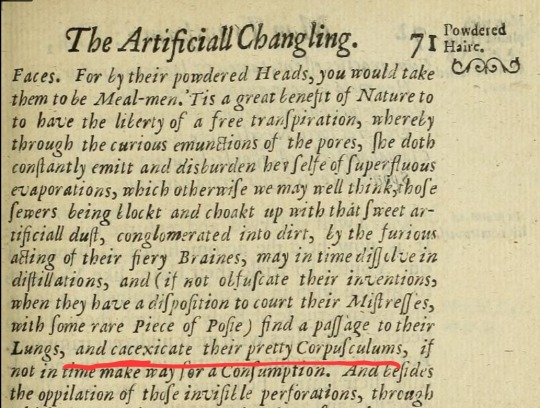
And so the picture comes together. Now I can finally come face to face with the kind of person who would invent a word like Corpusculum, and cement it forever in the language of science. Take whatever joy you can in hell today, Mr John Bulwer, because hell will seem like a relief after I find you there some day.
#science#optics#quantum physics#history#rene descartes#sir isaac newton#Ibn Sahl#Snell#Jābbir ibn Hayyān#Geber#pseudo-geber#robert boyle#Boyle's law#Snell's law#john Bulwer#alchemy#al-kimiya
5 notes
·
View notes